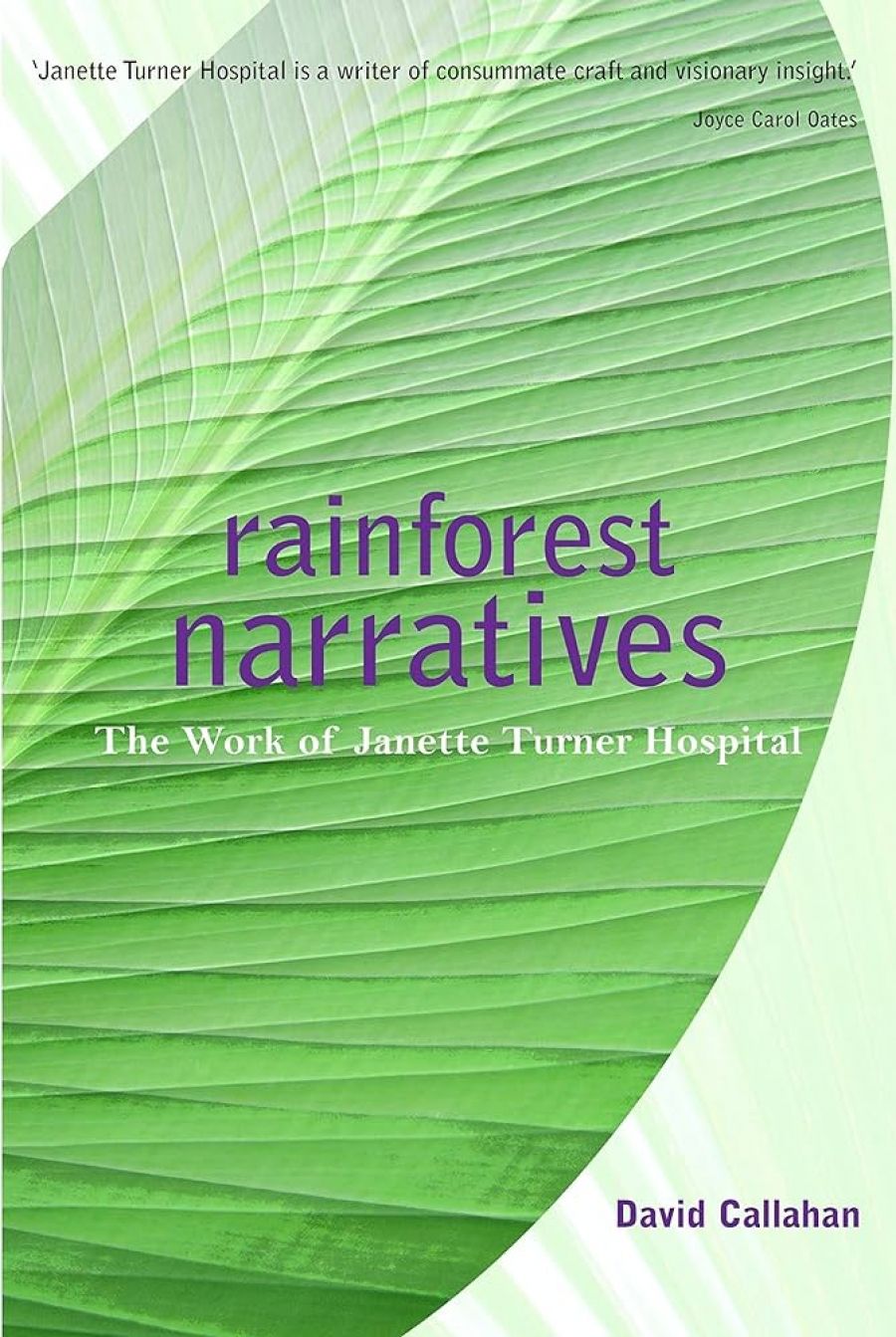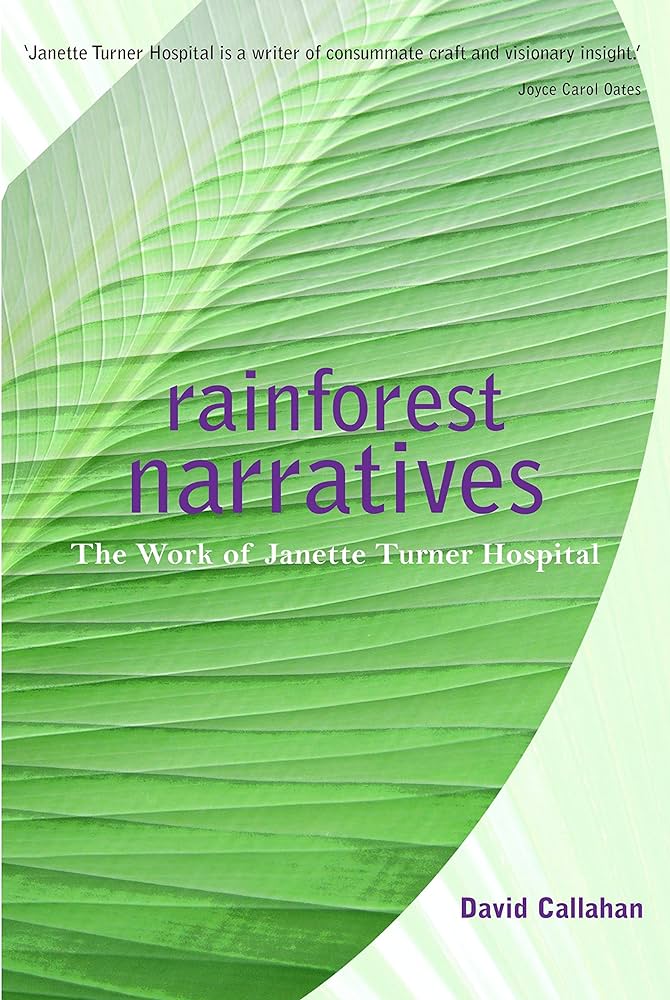
- Free Article: No
- Contents Category: Literary Studies
- Review Article: Yes
- Article Title: A peripatetic life
- Online Only: No
- Custom Highlight Text:
Janette Turner Hospital is an Australian-born novelist with an international reputation, though Australian readers often have reservations about her work. She has written some brilliant short stories, but her novels can strain for effect, with insistent intellectual allusions and postmodern shifts of fictional status. Perhaps, though, this is a typical Australian response to an expatriate writer whose work is not immediately accessible. Australian critics have not been as willing to praise Hospital as some North American readers, including Joyce Carol Oates, who, on the cover of Rainforest Narratives, describes Hospital as ‘a writer of consummate craft and visionary insight’.
- Book 1 Title: Rainforest Narratives
- Book 1 Subtitle: The Work of Janette Turner Hospital
- Book 1 Biblio: University of Queensland Press, $39.95 pb, 370 pp
- Book 1 Cover Small (400 x 600):

- Book 1 Cover (800 x 1200):

Hospital left Australia in 1967 when her husband was awarded a doctoral fellowship to Harvard. In 1971 they moved to Kingston, Ontario. Hospital’s early published fictions were received as the work of a Canadian; her first book, The Ivory Swing (1982), won the Canadian Seal award for best first novel. In the late 1980s she began returning regularly to Australia, taking up various writing fellowships in universities. She now holds a chair in English at the University of South Carolina, Columbia. Unlike other expatriate novelists – Henry Handel Richardson writing about life in Melbourne and Ballarat, or James Joyce remembering Dublin – Hospital draws on her experiences as an international citizen.
It seems appropriate that David Callahan, an expatriate who teaches at the University of Aveiro in Portugal, should write the first full-length study of Hospital’s fiction. He reads her work from a post-colonial perspective, emphasising its self-consciousness and Hospital’s insistence that fiction be acknowledged as a creative construction rather than as a reflection of the real world. She is a moralist, though, and her postmodernist strategies never deny the reality of suffering and oppression. Callahan sees the rainforest metaphor as appropriate to the complex density of Hospital’s fiction; he doesn’t promise to untangle all its overgrowth and reduce it to neat shrubbery. Instead, he makes connections between the novels, follows thematic and moral interests and identifies patterns within them. His reading suggests an alignment between Hospital’s shifting approach to fiction and her awareness of post-colonial and postmodernist literary theory.
The Ivory Swing, based on Hospital’s experience of Kerala on sabbatical with her husband, was innocent of these post-colonial sensitivities and, despite its appealing observation of exotic India, drew criticism for its ‘ethno-centric’ representation of caste and sexual oppression. Callahan explains that Hospital later admitted to ‘naïve arrogance’ in attempting to mediate between East and West, but I think the novel bears comparison with Arundhati Roy’s novel of caste and sexual oppression in Kerala, The God of Small Things (1997).
Hospital moved to a different milieu (middle-class Massachusetts) and a more sophisticated narrative structure in The Tiger in the Tiger Pit (1983). Callahan sees Borderline (1985) as her breakthrough novel, establishing the kind of cross-national characters and intricate shifts in plot evident in the later novels. Its critical success led to the publication of a book of short stories; Dislocations (1986) gives us sensitive, witty versions of Hospital’s world, alert to the absurdities and difficulties as people move across cultures. Callahan deals with each story in turn, aware that reading ‘post-colonially’ has its limits as an approach to the subtleties of these stories.
Charades (1988) shows Hospital in full postmodern flight, linking a physicist at MIT, an earth mother in the Queensland rainforest, Heisenberg’s Uncertainty Principle and the Holocaust. Callahan explains the way the novel’s structure enacts its concern about time, memory and the patterns of causality. It is the prime example for his ‘rainforest narrative’ metaphor, as Charade seeks meaning from the disparate elements in her own life. It is also a novel in which Hospital’s suggestive depiction of Queensland pierces through all its theoretical gestures.
Hospital’s very internationalism can make her novels seem generalised, imposing post-colonial templates on whatever place she writes about. This is, perhaps, what appeals to Callahan, who diligently explicates the patterns of oppression and the anti-realist shifts in each book. The Last Magician (1992), set in Sydney, indicates some of the problems for readers with more particular knowledge of her chosen settings. There is corruption, vice and poverty aplenty in Sydney, but it is not the same kind of oppression depicted in Sebastião Salgado’s photographs of miners in Brazil. Sydney has its corrupt judges, but they can get sent down for perjuring themselves over a speeding ticket. Hospital’s heart may be in the right place when she insists on the need to keep an eye on government officials and state threats to civil liberties, but Callahan’s claim that ‘most of the violence that is actually carried out against the inhabitants of Western countries is felt by many to come from their own governments’ seems a generalisation too far.
One of the great strengths of the novel as a form is its ability to delineate the particular and peculiar elements of experience. That may be why Hospital’s depictions of Brisbane schoolchildren in The Last Magician (1992) or life in the rainforest in Charades – and the sharp observation in most of her short stories – are so memorable. Her more recent work shows Hospital’s narrative skill, too. Callahan tells us that she began Due Preparations for the Plague (2003) well before 9/11, though it appears to be a response to the terrorist attacks.
Callahan notes in passing some of the more critical responses to Hospital’s fiction. At least once he can’t help commenting on a factual inaccuracy that undermines the logic of her plotting. By and large, though, he remains faithful to the task of explicating each of the novels and stories, without venturing too far beyond their range or asking too many questions about their weaknesses. This makes Rainforest Narratives a useful book, but a narrowly focused one. For all its international perspective, there is little attempt to place Hospital’s writing in the context of other contemporary writing, and the post-colonial/postmodernist approach seems to ignore other possibilities – Callahan hardly notices the erotic and sexual elements in the fiction.
For the most part, he writes clearly, with minimal reliance on theoretical clichés (though ‘suture’ and ‘avatar’ are overdone and, at one point, we are invited to read ‘postmodernistically’). I recommend reading the book alongside Selina Samuels’ article in Volume 325 of the Dictionary of Literary Biography for some sense of the relationship of the fiction to Hospital’s peripatetic life. Samuels also explains some of the details missing here, such as Hospital’s publication of A Very Proper Death (1990) under the pseudonym Alex Juniper.
Though UQP has not labelled this book part of its Studies in Australian Literature series, Callahan acknowledges the editorial assistance of Tony Hassall, the general editor of that series. This suggests that it may be the last of this important series, rather than the beginning of a renewed commitment by UQP to critical work on Australian writers. I hope that is not the case. It would be marvellous if UQP took up the ANU e-press model for books of this kind, making them accessible to any interested reader both online and in print.


Comments powered by CComment